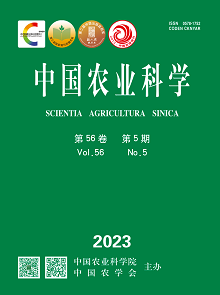【Objective】The aim of this study was to investigate the effects of green manure and wheat straw co-incorporation on water use efficiency of next season wheat (Triticum aestivum L.), which played an critical supporting role in the construction of water use efficient and sustainable production pattern of spring wheat in northwest irrigation region.【Method】In this study, a randomized block design was adopted, with fallowing after wheat harvesting (W) as the control, wheat multiple cropping green manure with no-tillage sowing + green manure and wheat straw co-incorporation (W-NTGS), wheat multiple cropping green manure with no-tillage sowing + green manure incorporation (W-NTG), and wheat multiple cropping green manure shallow plowing for destroying stubble + single returning of green manure to the field (W-TG). The characteristics of water consumption, grain yield, water use efficiency (WUE) and irrigation water use efficiency (WUEi) of wheat were investigated. 【Result】 The soil water storage in 0-50 cm soil layer before wheat sowing was significantly increased by multiple cropping green manure compared under W. The soil water storage in 0-10 cm, 10-20 cm, 20-30 cm, and 30-50 cm soil layers before wheat sowing with W-NTGS was increased by 22.1%, 30.2%, 21.5%, and 11.1% compared with that of W-NTG, and 26.2%, 33.2%, 26.5%, and 16.4% increase compared with that of W-TG, respectively. However, there was no significant difference in soil water storage in 0-110 cm soil layer before wheat sowing between W-NTG and W-TG. Compared with fallow treatment, water consumption, evaporation, and ratio of evaporation to evapotranspiration of wheat decreased by 7.0%-7.1%, 11.7%-20.1%, and 5.2%-15.9%, respectively. The water consumption of wheat with W-NTGS decreased by 6.4% than that of wheat under W-NTG in 2021, and averagely decreased by 6.1% than that of wheat under W-TG in 2020 and 2021. Compared with W-NTG and W-TG, the evaporation of wheat under W-NTGS decreased by 9.7% and 13.6% on average, and the ratio of evaporation to evapotranspiration decreased by 6.2% and 11.3%, respectively. There were no significant differences in water consumption, evaporation, and evapotranspiration ratio between W-NTG and W-TG. Compared with W, the grain yield of wheat multiple cropped with green manure increased by 6.4%-16.8%. Meanwhile, the grain yield of wheat under W-NTGS increased by 6.6% and 9.8% on average compared with W-NTG and W-TG, respectively. However, the grain yield of wheat between with W-NTG and W-TG was not significant difference. Compared with W, the WUE and WUEi of wheat multiple cropped with green manure increased by 11.9%-30.7% and 6.4%-16.8%, respectively. The WUE of wheat under W-NTGS increased by 10.9% and 16.8%, and the WUEi increased by 6.6% and 9.8%, respectively compared with W-NTG and W-TG. There were no significant differences in WUE and WUEi between W-NTG and W-TG.【Conclusion】 The co-incorporation of green manure and wheat straw (W-NTGS) could significantly increase soil water storage in 0-50 cm before wheat sowing, and decrease the ineffective loss of soil water in wheat season, thus reducing the water consumption of wheat and increasing the grain yield, and ultimately significantly improving the farmland and irrigation water use efficiency, which could be used as a recommended technology for water efficient use of wheat multiple cropping with green manure in arid irrigation region.









